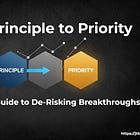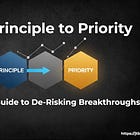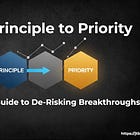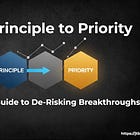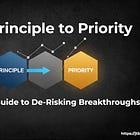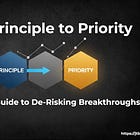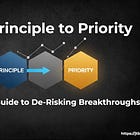From Principle to Priority: Chapter 3
First Principles: Deconstructing the “Problem As-Is”
This 10-article series is designed to disrupt common thinking about innovation. It provides a new framework to help you tear down old methods and invest more efficiently in breakthrough ideas. Please share!
Part 2
STAGE 1 - THE OPTION TO EXPLORE (Problem Deconstruction)
We have established our strategic “wrapper”: a Real Options framework that allows us to fund innovation not as a single gamble, but as a staged process of buying information. We have earned the right to make our first, small, and profoundly important investment: the Option to Explore.
The question for this stage is deceptively simple: “Is this a real, valuable, and unsolved problem for a specific group of people?”
The immediate, untrained impulse is to start brainstorming. To gather a team in a room with whiteboards and sticky notes and ask, “What are our customers’ pain points?” or “What are some new solutions we could build?” This impulse is a catastrophic error. It is reasoning from analogy, and it is the fastest path to incrementalism.
Reasoning from analogy means looking at what already exists and trying to make a slightly better version of it. It is the mental model of the incumbent. “Our competitor has feature X, so we should build feature X+1.” “Our customers are complaining about our user interface, so let’s redesign the interface.” “This process is slow, so let’s automate the existing steps.” These actions are not wrong, but they are not innovation. They are optimization. They are arguments from precedent, anchored entirely to the solution that exists today.
To find a breakthrough, we must reason from first principles.
First Principles Thinking is not a brainstorming technique. It is an industrial-grade deconstruction process. It is the intellectual equivalent of a particle accelerator: a tool designed to smash a complex problem, a “given,” into its most fundamental, indivisible components. The goal is not to find a new idea, but to find a fundamental truth.
We are not looking for pain points. We are looking for the axioms—the hidden, unstated, and universally accepted beliefs—that underpin the current problem and its surrounding solutions.
This is the primary work of the innovator. Before we can build, we must deconstruct. Before we can invent a new solution, we must unearth the obsolete assumptions that lock the current, inadequate solution in place.
Let’s make this tangible with a complex, modern problem that plagues thousands of global corporations: managing corporate carbon emissions.
If we reason from analogy, we would start by looking at existing solutions. We would find a world of carbon accounting software, consulting firms, and spreadsheet templates. We would interview ‘Sustainability Managers’ (our assumed Job Executor) and they would tell us about their “pain points”: “My data is in 50 different systems,” “The reporting standards keep changing,” “It’s hard to get our suppliers to send us their data.”
An analogy-driven team would immediately start designing a “better” solution: a more integrated software platform that connects to more systems, with more flexible reporting modules, and a new dashboard for supplier data. They would build a slightly more efficient version of the status quo.
A first-principles-driven team ignores the status quo entirely. Their objective is to find the fundamental truth of the problem, and they do it by asking a relentless, structured series of Socratic questions.
Question 1: What is the stated problem?
“We need to manage our corporate carbon emissions.”
Question 2: Why do we need to “manage” them? (Deconstruct the verb)
“Because we need to report them to regulators and investors.”
Question 3: Why do we need to “report” them?
“Because they represent a liability. Regulators will tax or fine us for them, and investors see them as a risk.”
Question 4: What is a “carbon emission” in this context? (Deconstruct the noun)
“It’s... a-tonne-of-CO2-equivalent. It’s a number in a database.”
Question 5: What is the fundamental purpose of this number?
“It is a proxy. It’s an agreed-upon, abstract unit of measurement for a verified environmental impact.”
Question 6: And what is the fundamental purpose of “reporting” this proxy?
“It’s not just reporting. The ultimate goal is to neutralize the liability. We report what we can’t reduce, and then we offset it.”
Question 7: What does it mean to “offset” it?
“It means we pay someone else to capture or avoid emitting one tonne of CO2, to balance our own.”
Here, after just a few questions, the team has smashed past the surface problem (”managing emissions”) and arrived at a far more fundamental, powerful concept. They have deconstructed the problem down to its axioms.
Axiom 1: A “carbon emission” is not a physical thing to be “managed,” but a financial instrument—a quantified, transferable liability representing a verified environmental impact.
Axiom 2: The current “solution” (carbon accounting) is not about environmentalism; it is a market mechanism for pricing and trading this new liability.
Axiom 3: The core process is not “reporting”; it is a transfer of economic value to neutralize a financial liability.
The team reasoning from analogy is now busy designing a better spreadsheet.
The team reasoning from first principles has just uncovered the blueprint for a new financial market. They are no longer thinking about “sustainability dashboards.” They are thinking about verification, non-fungibility, asset creation, and transactional integrity. They are asking questions the other team could never even conceive of:
“If this is a financial instrument, how is it created? How is the ‘asset’ (the offset) verified to be real?”
“How do we solve the ‘double spend’ problem (one offset being sold twice)?”
“How is title for this asset transferred and retired?”
“If the core process is a transfer of value, could we use smart contracts to bind the verification of impact directly to the payment, eliminating the need for 12-month-old data?”
This is the power of a First Principles deconstruction. It changes the entire problem space. It elevates the team from being a feature-builder to being a market-designer. It systematically dismantles the inherited assumptions (e.g., “this is a reporting problem,” “this is about spreadsheets”) and reveals the fundamental truth: “this is a problem of verifying and transferring a new kind of financial asset.”
This is the only way to find a truly disruptive, non-obvious opportunity. You do not find it by asking customers what they want. You find it by going on an archaeological dig into the problem itself. You must become an expert at separating the essential function (the underlying, fundamental truth) from the form it currently takes (the solution, the product, the process everyone hates but accepts as a given).
The output of this chapter, the goal of this entire stage, is to arrive at that one, potent, solution-agnostic statement. This is our First Principle.
The problem is not “managing carbon emissions.”
The First Principle is: “Organizations need to neutralize quantified environmental liabilities through a verifiable transfer of economic value.”
This single statement is the rock upon which we can now build. It is the solid, de-risked foundation for our exploration. We have used First Principles to define the true nature of the problem.
Now, we must use a second tool to define the human beings who are struggling with it. We must find the Job Executor. We must map their current, broken process. We must, in short, apply the Jobs-to-be-Done framework.
Guide to the Series
I make content like this for a reason. It’s not just to predict the future; it’s to show you how to think about it from first principles. The concepts in this blueprint are hypotheses—powerful starting points. But in the real world, I work with my clients to de-risk this process, turning big ideas into capital-efficient investment decisions, every single time.
Follow me on 𝕏: https://x.com/mikeboysen
If you’re interested in inventing the future as opposed to fiddling around the edges, feel free to contact me. My availability is limited.
Mike Boysen - www.pjtbd.com
De-Risk Your Next Big Idea
Masterclass: Heavily Discounted $67
My Blog: https://jtbd.one
Book an appointment: https://pjtbd.com/book-mike
Join our community: https://pjtbd.com/join



